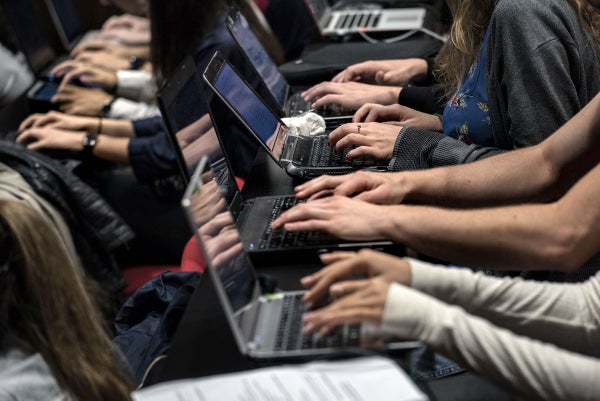To read the news, the sanctity of everything from college application essays to graduate school tests to medical licensing exams is imperiled by easy access to advanced artificial intelligence like ChatGPT, the AI chatbot that can produce remarkably clear, long-form answers to complex questions. Educators in particular worry about students turning to ChatGPT to help them complete assignments. One proposed solution is to roll back the clock to the 20th century, making students write exam essays using pen and paper, without the use of any Internet-connected electronic devices. The University of California, Los Angeles, where I teach, is considering making it an honor code violation to use ChatGPT for taking an exam or writing a paper.
That’s the wrong approach. This semester, I am telling the students in my class at the UCLA School of Law that they are free to use ChatGPT in their writing assignments. The time when a person had to be a good writer to produce good writing ended in late 2022, and we need to adapt. Rather than banning students from using labor-saving and time-saving AI writing tools, we should teach students to use them ethically and productively.
To remain competitive throughout their careers, students need to learn how to prompt an AI writing tool to elicit worthwhile output and know how to evaluate its quality, accuracy and originality. They need to learn to compose well-organized, coherent essays involving a mix of AI-generated text and traditional writing. As professionals working into the 2060s and beyond, they will need to learn how to engage productively with AI systems, using them to both complement and enhance human creativity with the extraordinary power promised by mid-21st-century AI.
On supporting science journalism
If you're enjoying this article, consider supporting our award-winning journalism by subscribing. By purchasing a subscription you are helping to ensure the future of impactful stories about the discoveries and ideas shaping our world today.
In addition to the sound pedagogical reasons for treating ChatGPT as an opportunity and not a threat, there are practical ones as well. It simply isn’t feasible to effectively ban access to this technology. Honor code or not, many students will be unable to resist the temptation to seek AI assistance with their writing. And how would an educational institution enforce a ChatGPT ban? While there are toolsaimed at detecting text produced by AI, future versions of AI will get better at emulating human writing—including to the point of emulating the style of the particular person who is using it. In the resulting arms race, the AI writing tools will always be one step ahead of the tools to detect AI text.
Enforcement of a ChatGPT ban would also inevitably produce the injustice of false positives and false negatives. Some students who use ChatGPT despite a ban would, through luck or thanks to careful-enough editing of AI-generated text, avoid having their writing flagged as AI-assisted. Worse, some students would be falsely accused of using ChatGPT, triggering enormous stress and potentially leading to punishment for a wrong they did not commit.
And what of the argument that learning to write well provides benefits that go well beyond writing? Writing a good essay from scratch requires careful, often painstaking, thought about organization, flow and communication. Learning to write without AI does indeed promote focused, disciplined thinking. But learning to successfully combine unassisted and AI-assisted writing to create truly good essays also requires these qualities.
Writing is a craft worthy of enormous respect, one which few of us ever master. But most students don’t aspire to become professional writers. Instead, they are preparing for careers where they will write to further goals beyond the production of writing. As we do today, they will write to communicate, explain, convince, memorialize, request and persuade. AI writing tools, when properly used, will help them do those things better.
When I was a middle and high school student in the late 1970s and early 1980s, I was told that professional success required good “penmanship” and the ability to perform long division by hand. By the time I entered the professional workforce in the late 1980s, technology advances had rendered those skills obsolete. Education culture can be very slow to change, as evidenced by the fact that many schools today still force children to learn long division—a task they will never have to perform anywhere outside of school. With AI writing, educators should stay ahead of the technology curve, as opposed to lagging decades behind it.
The upshot: I am helping my students to prepare for a future in which AI is simply another technology tool as opposed to a novelty. I am also telling them that they are solely and fully responsible for the writing they turn in bearing their name. If it’s factually inaccurate, that’s on them. If it’s badly organized, that’s on them. If it’s stylistically or logically inconsistent, that’s on them. If it’s partially plagiarized, that means that they have committed plagiarism.
In short, I’m encouraging my students to become responsible, aware users of the AI technologies that will play a profoundly important role over the course of their careers. The AI writing, so to speak, is on the wall.
This is an opinion and analysis article, and the views expressed by the author or authors are not necessarily those of Scientific American.
